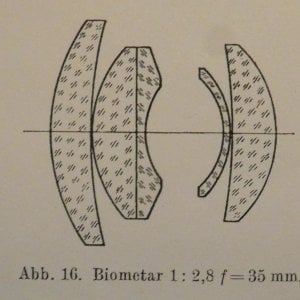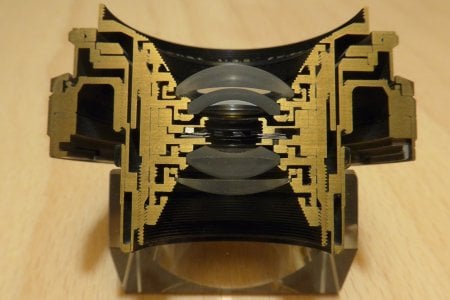das
Well-known
Hiya! Quick question for the Contax experts out there. Does anyone have a lens diagram for the West German 1950s 35mm f/3.5 Contax Planar? I saw some site report that it was 5 elements in 4 groups, so I was wondering if it were a Xenotar / Biometar type (you know, the design with the little curved lens as the third group) or some other type of design. Thanks!
dexdog
Mentor
I checked my reference books, could not find a diagram. I found this page, used a browser extension to translate from the original Japanese. It has a diagram a short way down the page. I was impressed that this person tore the lens completely apart
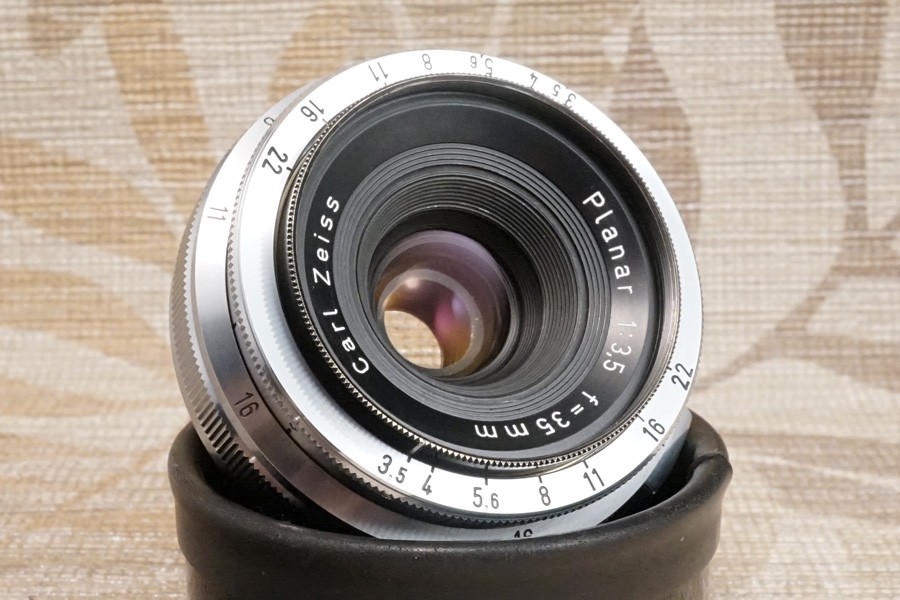

◎ Carl Zeiss (カールツァイス) Planar 35mm/f3.5(旧CONTAX C)
(以下掲載の写真はクリックすると拡大写真をご覧頂けます) 写真を閉じる際は、写真の外 (グレー部分) をクリックすれば閉じます 今回の掲載はオーバーホール/修理ご依頼分のオールドレンズに関する、ご依頼
pakira3.sakura.ne.jp
Last edited:
das
Well-known
Oh wow. Thanks for that! I had assumed that the Planar may have resembled the Zeiss Jena 35mm f/2.8 Biometar, but it seems like it is completely different, more conventionally symmetrical.
The Canon 50/2.2 also uses this 5/4 layout.
JakobN
JakobN
das
Well-known
Biometar and 35mm Planar share the same basic formula, just inverted.
Wow that's a great observation.
TenEleven
Well-known
Don't take me wrong, I am not trying to be Mr. Know-it all, but the Planar literally IS the Biometar, or rather the Planar is the completion of Dr. Wanderslebs and Dr. Sauers plans that got drawn up with the Biometar before Zeiss was split into east and west. Optically they basically follow the same idea of trying to reduce the flare of the original (Rudolph) Planar design in a time when coatings were not quite as good as they are today.
The camera where the Planar is clearly different from the Biometar is the Rolleiflex which moves the cemented doublet into the front element bringing the design closer to their ancestor - the archetypical Topogon which basically is the most reductionist double Gauss lens possible.
Anyway back to the Contax lens, it is interesting that Jena was able to push this design to 2.8 with very little concessions made to sharpness and flatness of field. The western variant has more contrast and richer more saturated colors. The trade-off is slightly larger field curvature, however, at least on film not to a meaningful degree. This may simply have been a conscious choice due to the difference in time when these lenses came out as color -- and reversal film especially was becoming more mainstream. And the aperture may have served to differentiate it from the much pricier f2.8 Biogon.
The camera where the Planar is clearly different from the Biometar is the Rolleiflex which moves the cemented doublet into the front element bringing the design closer to their ancestor - the archetypical Topogon which basically is the most reductionist double Gauss lens possible.
Anyway back to the Contax lens, it is interesting that Jena was able to push this design to 2.8 with very little concessions made to sharpness and flatness of field. The western variant has more contrast and richer more saturated colors. The trade-off is slightly larger field curvature, however, at least on film not to a meaningful degree. This may simply have been a conscious choice due to the difference in time when these lenses came out as color -- and reversal film especially was becoming more mainstream. And the aperture may have served to differentiate it from the much pricier f2.8 Biogon.
dexdog
Mentor
dexdog
Mentor
dexdog
Mentor
TenEleven
Well-known
Thank you @dexdog so much for posting this comparison.
I am fascinated by the differences to the results I got from these lenses on film.
The corners seem worse on the Biometar (most likely due to the steep ray angles) but the vignetting on the Planar is indeed extreme - I wonder if that same (perhaps mechanical?) vignette is what helps the corners on digital? Very strange - but interesting!
Edit: you can see the curvature I mentioned on the Planar a bit there, I don't think the bird bath (at least that's what I think it is?) should be in focus for that focus distance at f/3.5...
Edit two: You can also see that the Planar has oodles of resolution on digital, on film it's a lot closer - I believe mainly due to at least the 100 speed film (FP4+,UN54) I use not resolving nearly as much.
I am fascinated by the differences to the results I got from these lenses on film.
The corners seem worse on the Biometar (most likely due to the steep ray angles) but the vignetting on the Planar is indeed extreme - I wonder if that same (perhaps mechanical?) vignette is what helps the corners on digital? Very strange - but interesting!
Edit: you can see the curvature I mentioned on the Planar a bit there, I don't think the bird bath (at least that's what I think it is?) should be in focus for that focus distance at f/3.5...
Edit two: You can also see that the Planar has oodles of resolution on digital, on film it's a lot closer - I believe mainly due to at least the 100 speed film (FP4+,UN54) I use not resolving nearly as much.
Last edited:
dexdog
Mentor
Raining hard at my house at the moment, may try the same setup on my Nikon Z6 if the rain lets up. The Z6 tends to do better than the Sony a7iii with wide angle lenses. I have not used the Nikon in a while, need to charge the battery first.
TenEleven
Well-known
Now you got me digging around my old "test" folder and I found the appropriate scans. Lucky! As far as I know this is actually 100 speed color film that I scanned in black and white for expediency since it was just a test to verify a repair.
Both lenses at infinity, wide open on a late model color-dial Contax IIa.
If you scrutinize the image at 100% you can see that the Planar both has the field curvature (closer objects appear in better focus), but also a slight edge in resolution over the Biometar. Especially at the extremes of the frame. However if you consider that there is almost a stop speed difference and both use 5 glasses in the same time-period I would say that this is a commendable achievement for the Biometar.
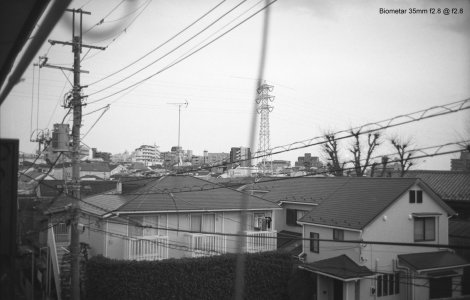
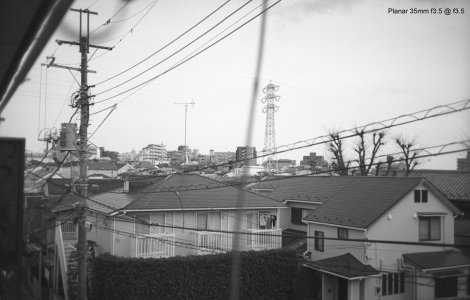
Both lenses at infinity, wide open on a late model color-dial Contax IIa.
If you scrutinize the image at 100% you can see that the Planar both has the field curvature (closer objects appear in better focus), but also a slight edge in resolution over the Biometar. Especially at the extremes of the frame. However if you consider that there is almost a stop speed difference and both use 5 glasses in the same time-period I would say that this is a commendable achievement for the Biometar.


dexdog
Mentor
Nikon Z6, autoexposure, straight jpeg, colors set to natural/neutral, ISO 100 Results between the two digital cameras are fairly similar. The Planar has better resolution towards edges of frame, but corners are darker, Biometar has lesser resolution towards edges of frame, but corners are not near as dark.
Biometar f2.8

Planar f3.5

Biometar f2.8

Planar f3.5

Last edited:
dexdog
Mentor
dexdog
Mentor
TenEleven
Well-known
Thanks for posting these, interestingly the Biometar seems to fare worse on the Nikon Z6 than the Sony A7III...
dexdog
Mentor
Digital cameras will drive me nuts, The Nikon is often "better" with 35mm focal length (less corner smearing) than the Sony, but not consistently in my opinion. I think that Nikon is definately better with 28mm focal length than the Sony, but given given that I loathe 28mm focal length not really an issue for me! By the way, both of those old lenses are in very good condition, with nice clear glass
TenEleven
Well-known
Yeah it is why I am always wary of lens "reviews" on digital cameras. It tells me almost nothing about how a certain lens will perform on film, for example. Or even on another digital camera with a different sensor stack.
I mean it is possible to make some general predictions, for example Biogon and Sonnar types usually fare much worse on digital than Planar derivates. And as you already said, longer lenses are usually a better fit as well - I assume since the rays come in straighter. Wide angles can be quite a headache especially if they sit close to the sensor... italian flag, vignette and other strange artifacts make an appearance
I mean it is possible to make some general predictions, for example Biogon and Sonnar types usually fare much worse on digital than Planar derivates. And as you already said, longer lenses are usually a better fit as well - I assume since the rays come in straighter. Wide angles can be quite a headache especially if they sit close to the sensor... italian flag, vignette and other strange artifacts make an appearance
dexdog
Mentor
Throw in the complicating factor of adapters, and it can be a real can of worms.
Share:
-
This site uses cookies to help personalise content, tailor your experience and to keep you logged in if you register.
By continuing to use this site, you are consenting to our use of cookies.


